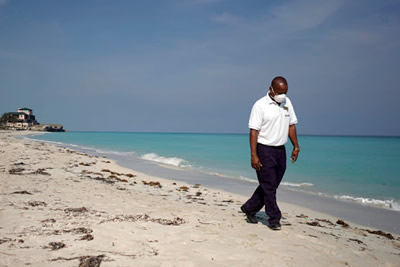Written by By Pamela Coke-Hamilton, Director, Division on International Trade and Commodities, UNCTAD
The COVID-19 pandemic and the measures put in place to contain its diffusion are taking a heavy toll on the tourism sector.
According to the United Nations World Tourism Organization (UNWTO), the COVID-19 pandemic will result in a contraction of the tourism sector by 20% to 30% in 2020.
This estimate is likely to be conservative for countries relying on foreign tourists, as the recent data on daily air traffic indicate a drop of almost 80% since January 2020.
While many economic sectors are expected to recover once restrictive measures are lifted, the pandemic will probably have a longer lasting effect on international tourism.
This is largely due to reduced consumer confidence and the likelihood of longer restrictions on the international movement of people.
According to the World Travel and Tourism Council (WTTC), in previous viral epidemics the average recovery time for visitors to a destination was about 19 months.
Highly vulnerable countries
The sudden, deep and likely prolonged downturn in the travel and tourism sector has made countries that rely heavily on foreign tourism very concerned about their finances.
Among these, small island developing states (SIDS) are most vulnerable not only because they are highly dependent on tourism, but also because any shock of such magnitude is difficult to manage for small economies.
On average, the tourism sector accounts for almost 30% of the gross domestic product (GDP) of the SIDS, according to WTTC data. This share is over 50% for the Maldives, Seychelles, St. Kitts and Nevis and Grenada.
Overall, travel and tourism in the SIDS generates approximately $30 billion per year. A decline in tourism receipts by 25% will result in a $7.4 billion or 7.3% fall in GDP. The drop could be significantly greater in some of the SIDS, reaching 16% in the Maldives and Seychelles.
It is expected that for many SIDS, the COVID-19 pandemic will directly result in record amounts of revenue losses without the alternative sources of foreign exchange revenues necessary to service external debt and pay for imports.
Devastating economic consequences
In general, countries may be able to weather economic storms by relying on additional debt or using available foreign reserves.
However, access to global capital markets is increasingly tight, more so for small countries such as SIDS, which are often highly indebted and not well diversified.
The external debt of the SIDS as a group accounts for 72.4% of their GDP on average, reaching up to 200% in the Seychelles and the Bahamas.
Foreign reserves are also generally low, with many of the SIDS possessing only the reserves sufficient for a few months of imports. Given these statistics, it is evident that without international assistance, the economic consequences of the pandemic will be devastating for many of the SIDS.
Immediate financial needs
By considering the economic impact of reduced tourism revenues (assuming a 25% decline in tourism receipts ) and restoring the minimum level of import coverage (three months), it is possible to provide a rough estimate of each country’s immediate financial needs to offset the damage of the pandemic.
Currently, the SIDS would need about $5.5 billion to counteract the adverse effects of the pandemic on their economies.
The Maldives stands out with a need of $1.2 billion due to its reliance on tourism revenues, followed by the Bahamas and Jamaica.
Many of the SIDS, like Jamaica and the Bahamas, also face high external debt burdens which require complementary external debt suspension or relief programmes.
Table 1: Tourism, Debt and Foreign Currency Reserve Indicators
International response
While governments all over the world have announced fiscal measures totalling $8 trillion to combat the pandemic, the international community has also mobilized funds through international financial institutions to counteract the economic crisis in the most vulnerable countries.
The International Monetary Fund (IMF) created a $50 billion fund through its rapid-disbursing emergency financing facilities for low-income and emerging market countries.
It has earmarked $10 billion to serve its poorest members with a zero-interest rate. Regional banks have also created response facilities aimed at financially supporting their members.
What options are available for SIDS?
The IMF has just revamped the Catastrophe Containment and Relief Trust (CCRT) to offer short term debt reliefs to some of its members.
While some SIDS such as Comoros, São Tomé and Príncipe, and the Solomon Islands have already requested and obtained debt relief, there is room for more SIDS to take advantage of this option.
While many of the SIDS are not among the poorest countries, they are vulnerable. This is further compounded by high levels of external debt many SIDS experience.
It is critical that SIDS have access to funding at zero interest rates and can suspend existing debt payments until they are financially ready to service their external debt obligations.
Ultimately, this can help blunt the impact of external shocks such as COVID-19 and equip them with the necessary financial resources to plan their next steps for their economic development.


